Overview
In 2025, healthcare professionals face significant emotional challenges, particularly when it comes to managing documentation and patient care. The administrative burdens can feel overwhelming, often detracting from the time spent with patients. However, there is hope. The top seven speech recognition software options are here to help, offering solutions that can ease these pressures.
These advanced technologies not only streamline administrative tasks but also reduce errors, allowing clinicians to focus more on what truly matters—patient interactions. Imagine a world where documentation is efficient, freeing up precious time for healthcare providers to connect with their patients. This transformation is possible, and it can significantly enhance the quality of care provided.
By adopting these innovative tools, healthcare professionals can experience a profound shift in their daily routines. The benefits are clear:
- Improved documentation efficiency
- Reduced stress
- Ultimately, better patient care
Are you ready to explore how these solutions can transform your practice?
Let’s take a closer look at how these speech recognition software options can support you in your vital role. Together, we can navigate the complexities of healthcare delivery, ensuring that both providers and patients thrive in a more efficient and compassionate environment.
Introduction
In the rapidly evolving landscape of healthcare, many providers face emotional challenges as they strive to deliver the best patient care. The demands of documentation can feel overwhelming, taking precious time away from what truly matters—patient interactions. Speech recognition technology emerges as a transformative force, reshaping how medical professionals document these vital interactions. By harnessing advanced algorithms and machine learning, this technology not only streamlines documentation but also enhances the quality of patient care.
As healthcare providers increasingly adopt these solutions, they reclaim valuable time previously lost to administrative tasks. Imagine the relief of focusing more on patients rather than paperwork. However, it’s important to acknowledge that challenges such as integration and accuracy persist. This prompts a closer examination of how these tools can be effectively implemented in daily practice.
As the industry moves towards a future where voice technology plays a pivotal role, understanding the implications and benefits of speech recognition in healthcare becomes essential. Providers committed to delivering exceptional patient experiences must explore these innovations. Together, we can navigate this journey towards a more efficient and compassionate healthcare environment.
Understanding Speech Recognition Technology in Healthcare
Advancements in voice processing have truly transformed the way medical professionals engage with speech recognition software. This technology, which converts spoken language into text with remarkable efficiency, alleviates some of the emotional burdens healthcare providers face. By harnessing sophisticated algorithms and machine learning, speech recognition software adeptly recognizes diverse accents and medical terminologies, becoming an invaluable asset in clinical environments. As we look towards 2025, the increasing adoption of this technology suggests a promising shift, with research indicating it can significantly reduce documentation time, allowing providers to focus more on what truly matters: client care.
It's heartening to note that the AI sector is expected to generate 9% of new jobs in the US, reflecting the evolving role of medical providers in this technological landscape. Current trends emphasize a growing focus on on-device processing solutions, which enhance both efficiency and security in voice command processing, freeing providers from reliance on cloud services. For instance, NXP Semiconductors has introduced a Speech to Intent Engine that addresses latency and power consumption issues, ultimately improving user experiences across various applications.
The impact of speech recognition software extends beyond mere documentation; it plays a crucial role in enhancing healthcare by streamlining administrative tasks. By automating processes like appointment scheduling and medical record management, providers can improve the accuracy of patient records—an essential element for effective treatment planning. Recent surveys reveal that while 39% of respondents express concerns about AI's impact on the patient-physician relationship, many remain hopeful about its potential to improve health outcomes.
This mixed perception highlights the importance of ethical considerations in AI implementation, especially in faith-focused medical settings like those championed by CosmaNeura. Case studies illustrate the tangible benefits of speech recognition technology. Medical facilities that have adopted this software report significant increases in job satisfaction among clinicians, who can reclaim hours once spent on administrative tasks. This shift not only boosts provider morale but also enhances the overall experience, allowing for more meaningful interactions with clients.
As Dnyaneshwar, a team leader known for his problem-solving skills, emphasizes, incorporating advanced AI solutions is essential for achieving project excellence and delivering state-of-the-art medical services.
In summary, the importance of speech recognition software in the medical field cannot be overstated. It enhances documentation efficiency and fosters a more compassionate, focused approach to patient care. This aligns seamlessly with the mission of medical providers to deliver exceptional clinical experiences while upholding ethical medical practices. Together, let us embrace these advancements to create a brighter future in healthcare.
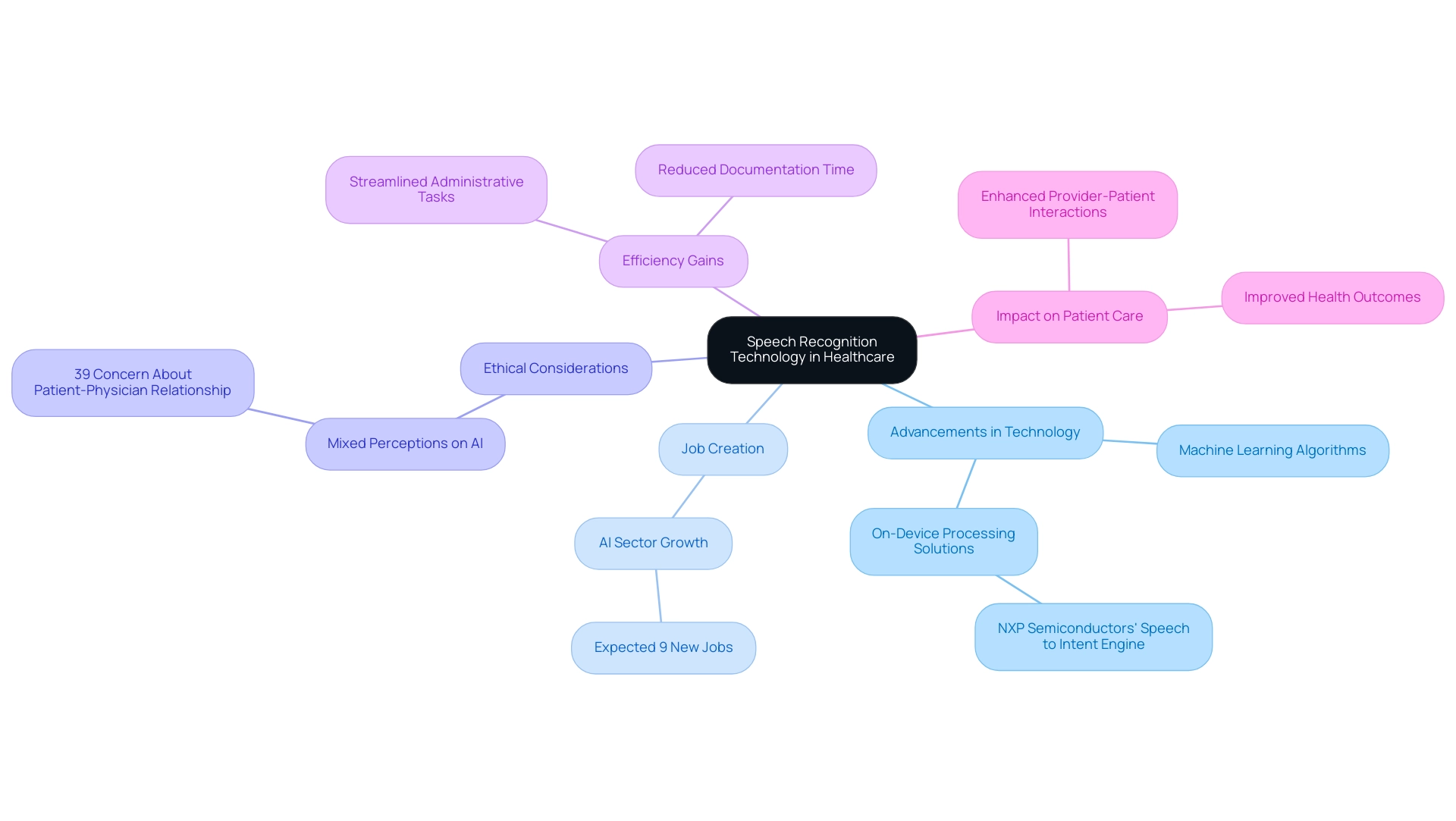
The Role of Speech Recognition in Reducing Administrative Load
Speech recognition software in the medical field is truly transforming how healthcare providers manage documentation, significantly reducing the time spent on administrative tasks. By allowing clinicians to dictate notes directly into electronic health records (EHRs), this innovation minimizes the need for manual data entry, which can be both time-consuming and prone to errors. However, navigating the healthcare landscape can be challenging. Many providers hesitate to embrace innovation due to concerns about maintaining the quality of care and their interactions with patients.
This resistance often leads to technology sales conversations spiraling into a 'clinical rabbit hole.' Here, the focus shifts away from the benefits of the technology to the potential risks involved. Yet, recent research indicates that 81.63% of physicians are enthusiastic about utilizing intelligent assistance in care, following a notable 38.1% improvement in administrative task completion and a 29.5% reduction in time spent on routine work.
The benefits of implementing speech recognition software extend beyond mere time savings. By optimizing documentation procedures, providers can concentrate more on patient interactions, ultimately improving the standard of care offered. This shift fosters a more compassionate healthcare environment and contributes to greater job satisfaction among clinicians, who can reclaim several hours each day previously consumed by routine administrative duties.
As Mike Sutten, CTO at Innovaccer, aptly stated, "Imagine giving doctors back more than two hours every day to focus on what they do best: caring for individuals."
Moreover, the impact of speech recognition software on documentation accuracy cannot be overstated. With fewer manual entries, the likelihood of errors diminishes, leading to more reliable patient records. This is especially vital in a context where data security is essential; with 87% of organizations reporting data breaches, the need for accurate and secure documentation is more pressing than ever.
The average cost of a medical data breach amounts to $7.13 million, emphasizing the significance of strong documentation practices.
Examples of medical providers successfully leveraging speech recognition technology illustrate its potential:
- eClinicalWorks serves over 850,000 medical professionals and reported an annual revenue of $1.3 billion.
By adopting these solutions, practices not only enhance their operational efficiency but also improve patient care outcomes.
As leaders in the medical field emphasize the importance of documentation efficiency, integrating speech recognition software emerges as a vital strategy for reducing administrative burdens and fostering a more effective delivery system. Moreover, CosmaNeura's platform aligns with these improvements by providing administrative efficiency and compliance with Catholic teachings, ensuring that providers can concentrate on delivering compassionate care while addressing the challenges that often arise with new innovations. CosmaNeura has effectively managed the obstacles of innovation resistance by offering customized assistance to medical startups, helping them overcome the barriers that frequently lead to reluctance in embracing new advancements.
Key Features to Consider in Medical Speech Recognition Software
When evaluating medical speech recognition software, it is essential to prioritize several key features to ensure optimal performance and integration within healthcare settings:
- Accuracy: A high accuracy rate is crucial, especially when transcribing complex medical terminology and accommodating various accents. Leading innovations in the field, such as Speechmatics, boast accuracy rates as high as 98%, significantly reducing the need for manual corrections. This level of precision is vital for medical providers who rely on accurate documentation for patient care, ultimately enhancing patient outcomes.
- Integration: Compatibility with existing Electronic Health Record (EHR) systems is fundamental for streamlining workflows. As the medical transcription landscape evolves, seamless integration will enhance efficiency and reduce administrative burdens. Ian Shakil, Founder of Augmedix, emphasizes the importance of real-time performance in integration, stating, "This is a significant leap forward for Augmedix’s advancement... our clinician customers frequently expect note delivery to occur in real-time." By leveraging AI technology, CosmaNeura's solutions can further bridge gaps in communication and coordination among providers, addressing the fragmentation often seen in medical delivery. CosmaNeura's software also includes features for appointment scheduling and medical record management, which are essential for improving overall administrative efficiency.
- Customization: The ability to tailor the software to specific medical specialties and user preferences is vital. This feature allows medical providers to optimize their workflows and improve the relevance of transcriptions, thereby alleviating some of the administrative burdens that contribute to physician burnout.
- Security: Compliance with HIPAA regulations is non-negotiable. Ensuring that the software protects user data is paramount in maintaining trust and safeguarding sensitive information, which is essential in a landscape where privacy is a top concern.
- User Support: Reliable customer support is essential for maintaining productivity when using dictation tools. Effective support can assist with troubleshooting and optimizing software use, ensuring that providers can focus on patient care without unnecessary interruptions.
As the medical transcription field progresses, advancements in AI and machine learning are expected to enhance transcription accuracy and efficiency. According to the case study titled "Trends to Expect in Medical Transcription by 2025," the integration of these technologies will likely lead to enhanced speech understanding capabilities, better EHR integration, and a heightened focus on data security, all while still requiring human oversight for error-free records. These trends highlight the significance of choosing the appropriate speech recognition software that matches the evolving requirements of medical providers.
Notably, CosmaNeura stands out as the only company creating AI solutions specifically for the faith-focused medical sector, reinforcing its commitment to enhancing the quality of care while embodying the compassionate spirit of Catholic services. User testimonials emphasize the effectiveness of CosmaNeura's solutions in reducing administrative burdens and enhancing interactions, further establishing the credibility of its offerings.
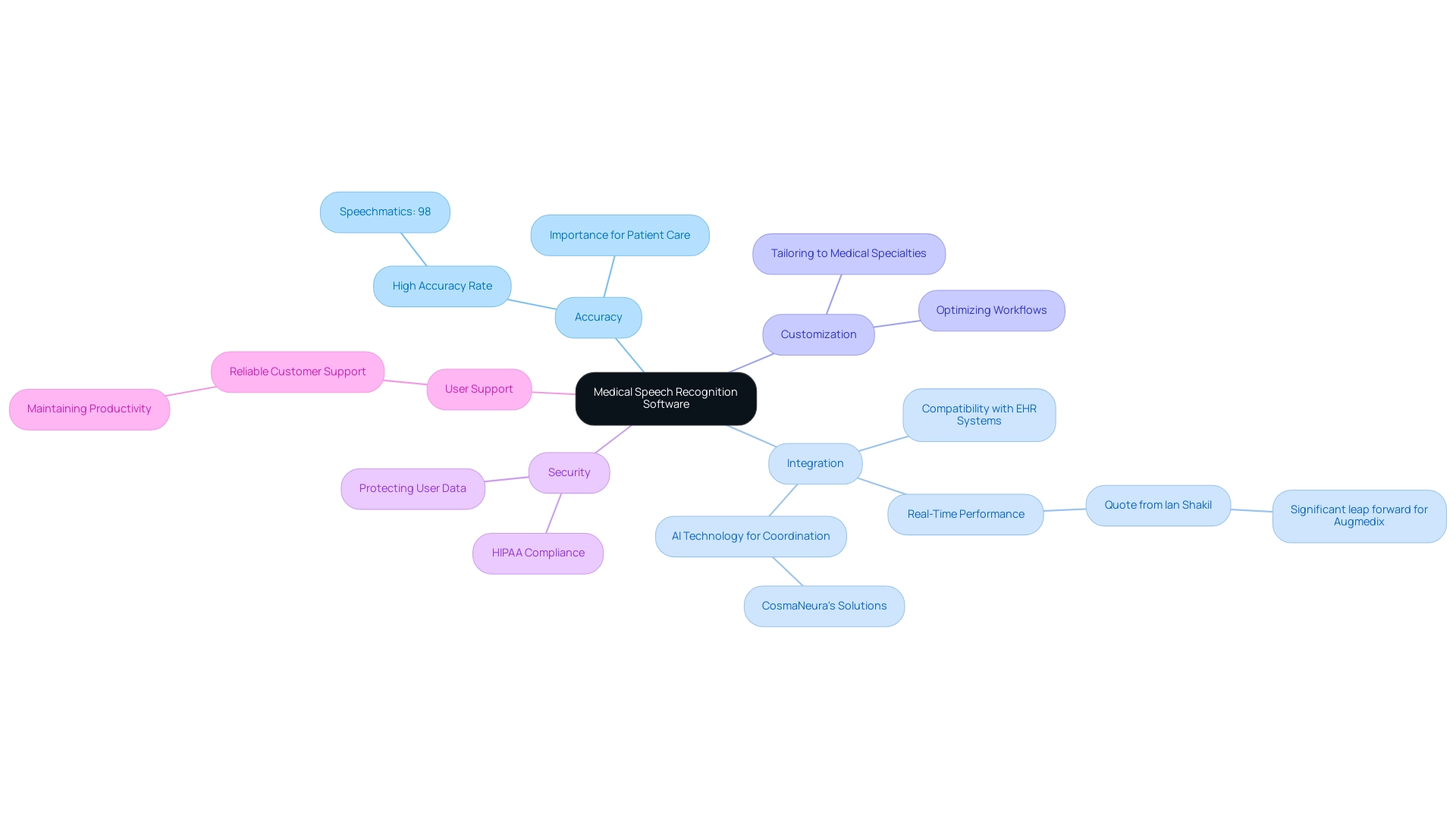
Top 7 Speech Recognition Software for Medical Professionals in 2025
In 2025, medical professionals face numerous challenges, particularly in managing clinical documentation and client interaction. Fortunately, advanced speech recognition software options are available to alleviate these burdens, allowing healthcare providers to focus on what truly matters—their patients. Here are the top seven choices:
- Nuance Dragon Medical One: Celebrated for its exceptional accuracy and comprehensive medical vocabulary, this software is a staple among healthcare providers. Its integration with electronic health records (EHRs) streamlines documentation, enabling clinicians to concentrate more on care.
- DeepScribe: An innovative AI-powered solution, DeepScribe automates note-taking during consultations, capturing conversations in real-time. This not only saves time but also ensures that critical information is accurately documented, enhancing the overall quality of care.
- Amazon Transcribe Medical: Known for its high accuracy in real-time transcription, Amazon Transcribe Medical meets the specific needs of medical providers. Its cloud-based architecture allows for seamless integration into existing workflows, facilitating efficient documentation.
- Twofold Health AI Scribe: Tailored for various medical specialties, Twofold Health AI Scribe ensures HIPAA compliance while providing a user-friendly interface. This software is particularly beneficial for practices looking to enhance patient engagement through accurate and timely documentation.
- M*Modal Fluency Direct: This tool integrates effortlessly with EHR systems, promoting efficient documentation practices. M*Modal Fluency Direct adapts to the unique requirements of various medical environments, making it a versatile option for providers.
- Philips SpeechLive: Emphasizing security and ease of use, Philips SpeechLive is designed specifically for medical professionals. Its robust features protect sensitive patient information while simplifying the documentation process.
- Speechmatics: Renowned for its machine learning capabilities, Speechmatics excels in adapting to various accents and dialects, making it a valuable tool in diverse medical settings. Its flexibility allows for accurate transcription across different languages and speech patterns.
The market for speech recognition software in healthcare is experiencing significant growth, with North America holding a dominant 51.3% revenue share in 2023. This growth is driven by advancements in AI and cloud-based solutions. As medical practitioners progressively embrace these innovations, user satisfaction scores for speech recognition software are anticipated to increase, indicating positive effects on clinical workflows and patient care. Notably, recent advancements in voice recognition technology, such as Sonde Health's acquisition of NeuroLex Labs and Canary Speech's patented technology for detecting medical conditions through speech analysis, illustrate the trend of leveraging voice technology in medical services.
Dr. Rupesh, a medical professional, remarked, "Augnito has truly revolutionized my radiology reporting process. The time savings and accuracy it offers are remarkable." He continued, "The challenges I faced with previous transcription software were frustrating, but Augnito’s innovative features, such as templates and macros, have rectified these issues and streamlined my reporting process."
"Augnito has exceeded my expectations," he added. With the ongoing advancement of these tools, medical professionals can anticipate greater efficiency and better results in their practices. CosmaNeura is leading this transformation, pioneering AI solutions designed for the faith-oriented medical sector, thereby improving the quality of care for individuals.
Benefits of Implementing Speech Recognition Software in Medical Practice
Implementing speech recognition software in medical practice offers a wealth of advantages that profoundly enhance both operational efficiency and patient care.
- Increased Efficiency: Imagine being able to document patient interactions much more swiftly, significantly cutting down the time spent on paperwork. This efficiency is underscored by projections indicating that the global voice AI medical market is poised to grow at a compound annual growth rate (CAGR) of 37.3% from 2023 to 2030, highlighting a strong trend towards automation in medical documentation.
- Improved Accuracy: Automated transcription capabilities can greatly reduce human error, leading to more reliable and precise records. This reliability is essential in a field where precision is critical, as inaccuracies can result in misdiagnoses or inappropriate treatments.
- Enhanced Patient Involvement: With less time devoted to documentation, medical providers can dedicate more attention to their patients. This shift not only elevates patient satisfaction but also cultivates a more compassionate care environment. By 2026, it's anticipated that 80% of medical interactions will include some form of speech recognition software, further emphasizing the importance of integrating these resources into practice.
- Cost Savings: Reducing administrative burdens can lead to lower operational costs and increased revenue potential. A study on the economic impact of speech recognition software in healthcare estimates that voice-enabled clinical documentation could save U.S. healthcare providers around $12 billion annually by 2027. Additionally, 44% of organizations are already utilizing voice solutions, reflecting its growing acceptance and effectiveness.
- Expert Insights: Healthcare providers have reported significant efficiency gains from adopting speech processing technology. For instance, Shankar Godavarti, a Global Product, Quality & Strategy Executive, shared, "The response was good, and I got what I was looking for as far as the report. Thank you for that." Many have noted that implementing speech recognition software allows them to document encounters quickly, enabling them to spend more quality time with patients, thereby enhancing the overall care experience.
- Real-World Examples: Numerous medical practices have experienced the benefits of utilizing speech identification software, noting improvements in workflow efficiency and patient interaction. One case study highlighted that a medical provider achieved a 30% reduction in documentation time after incorporating voice identification tools, leading to higher satisfaction scores among patients. These real-world instances illustrate how such innovations can transform daily operations, resulting in better outcomes and satisfaction for individuals.
In summary, incorporating speech recognition software into practice not only streamlines documentation procedures but also elevates the quality of care provided to patients. This makes it an essential tool for today's medical providers, fostering a more compassionate and efficient healthcare environment.
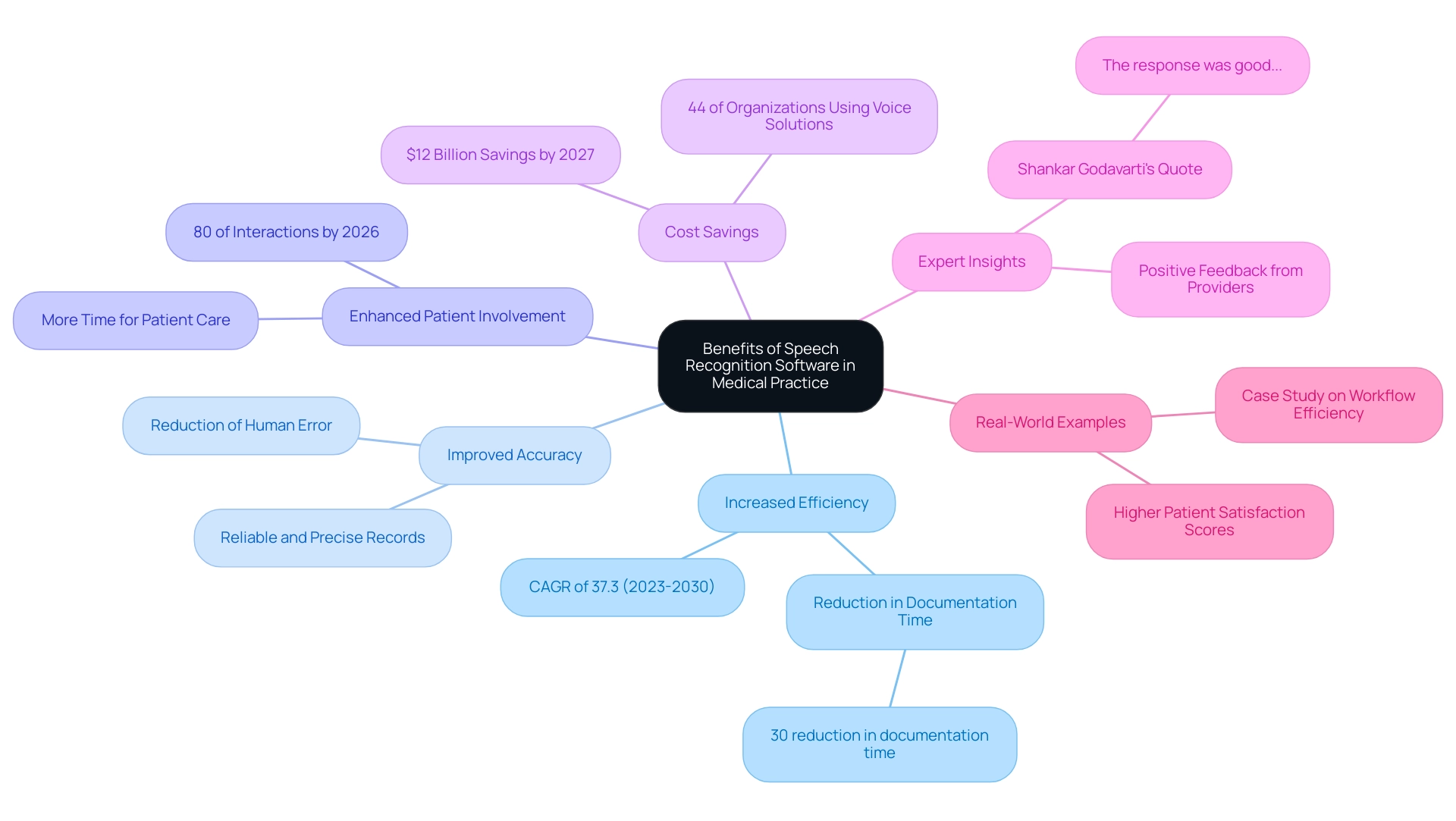
Challenges and Limitations of Speech Recognition in Healthcare
While speech recognition technology offers significant benefits, it also presents a range of challenges that healthcare providers must navigate with care:
- Accuracy Issues: One of the primary concerns is the variability in accents and dialects, which can lead to misinterpretations and inaccuracies in documentation. In 2025, studies suggest that up to 30% of healthcare professionals report facing challenges with speech clarity accuracy due to diverse patient backgrounds.
- Integration Difficulties: Integration difficulties can arise when implementing speech recognition software in medical settings due to compatibility issues with existing electronic health record (EHR) systems. Many providers find that integrating speech recognition software into their systems requires substantial adjustments to workflows, which can disrupt daily operations. For instance, a recent case study highlighted a medical practice that faced substantial delays in documentation due to integration issues with their EHR system, ultimately impacting care.
- Training Requirements: Effective utilization of speech recognition tools often necessitates comprehensive training for staff. This training can be time-consuming and may temporarily divert attention from care, creating a bottleneck in productivity during the transition period.
- Dependence on Technology: There is a growing concern that over-reliance on automated systems could diminish clinicians' documentation skills. As providers become accustomed to dictating notes rather than writing them, there is a risk of losing critical analytical skills that are essential for thorough evaluations.
- Expert Insights: Healthcare professionals have expressed their concerns about the limitations of existing speech recognition tools. Many express frustration over the system's inability to accurately capture nuanced medical terminology, which can lead to incomplete or erroneous patient records. Shankar Godavarti, a Global Product, Quality & Strategy Executive, noted, "The response was good, and I got what I was looking for as far as the report. Thank you for that," emphasizing the significance of efficient tools in addressing user needs.
- Current Challenges: In 2025, the difficulties of implementing speech identification systems remain considerable. Providers are still grappling with issues such as inconsistent performance across different environments and the need for ongoing technical support. Significantly, the market for speech recognition software in medical services is substantial, with Australia's revenue reaching USD 175 million, highlighting the financial consequences of these innovations.
- Case Studies: Real-world examples illustrate these challenges. For instance, a recent case study highlighted a medical practice that faced substantial delays in documentation due to integration issues with their EHR system, ultimately impacting care.
In summary, while advancements in speech recognition software hold promise for improving efficiency in medical documentation, medical providers must carefully consider these challenges to ensure successful implementation and uphold high standards of care. Cosmonaut, as a leader in the faith-oriented medical sector, is well-equipped to tackle these challenges and improve the quality of service for individuals.
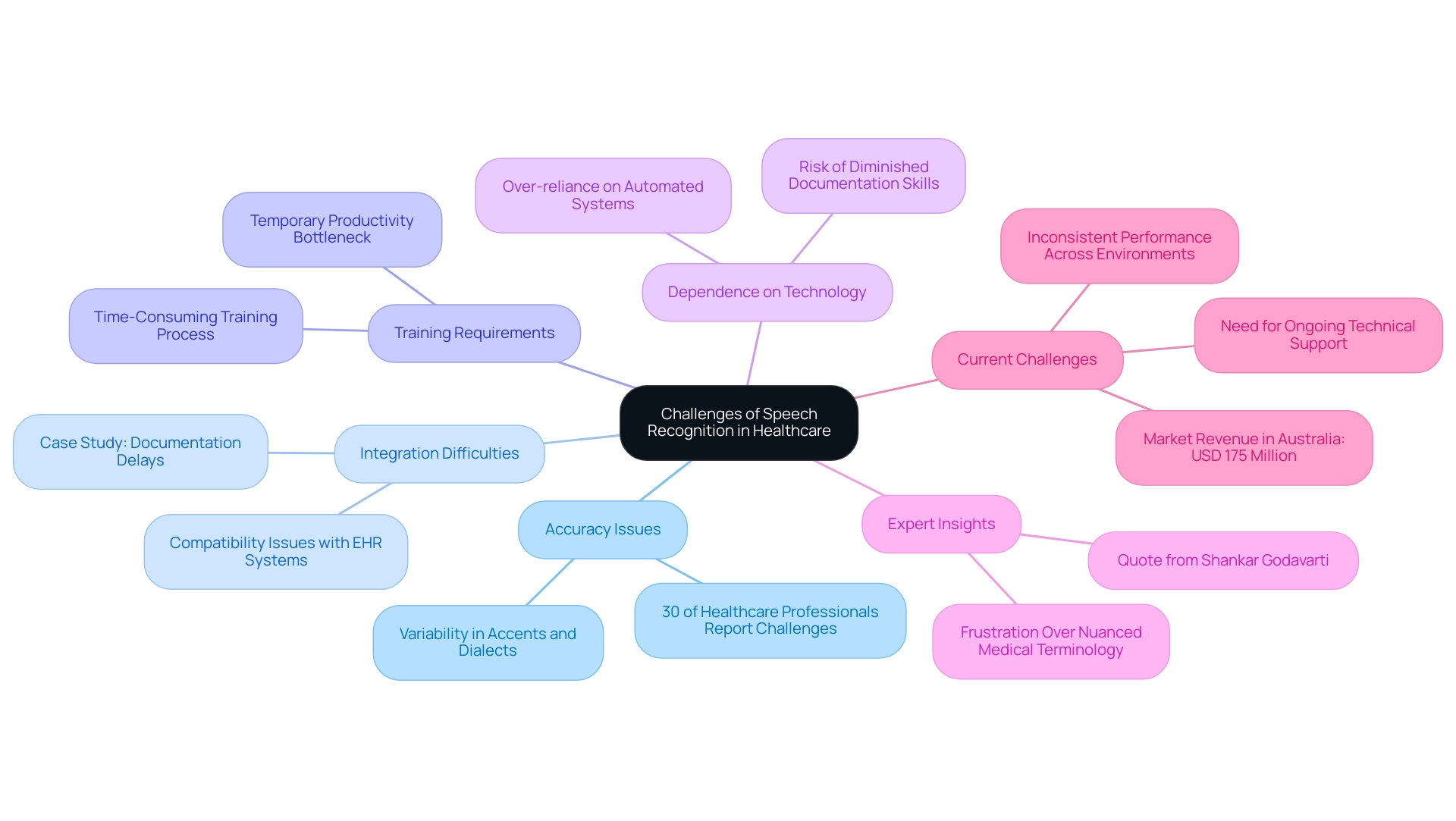
The Future of Speech Recognition Technology in Healthcare
The future of voice interpretation technology in the medical field, particularly speech recognition software, is set to transform the industry, driven by significant advancements in artificial intelligence and natural language processing. As medical professionals increasingly embrace these innovations, several key trends are emerging:
- Greater Integration: The seamless integration of voice identification tools with electronic health records (EHRs) and other medical systems is expected to enhance workflows. This will reduce the time spent on documentation, allowing providers to focus more on patient care. This shift addresses the common resistance to innovation in the medical field, where providers, especially physicians, often hesitate to adopt changes that might affect their interactions with patients.
- Enhanced AI Capabilities: As algorithms continue to improve, we can anticipate a notable increase in transcription accuracy and a better grasp of complex medical terminology. This enhancement will not only elevate the quality of documentation but also support clinical decision-making, tackling the challenges that startups face in gaining acceptance for their groundbreaking solutions.
As awareness of the benefits of speech recognition software grows, more healthcare providers are likely to implement these systems. Projections indicate that by 2025, a significant portion of medical professionals will rely on speech recognition software to transform their documentation practices, ultimately enhancing patient care. The necessity for secure and efficient documentation methods that AI can provide is underscored by the ongoing challenges within the medical sector.
- Future Trends: Experts foresee that advancements in AI will lead to more intuitive and user-friendly interfaces, simplifying the adoption and effective use of these technologies by providers. Furthermore, the integration of voice-activated assistants in clinical settings is anticipated to streamline operations even further. According to Deloitte, generative AI and automation could reduce the time revenue cycle staff spend on routine tasks by half, granting nurses 20% more time for direct patient care and thereby improving overall patient outcomes.
- Case Studies: CosmaNeura serves as a prime example of the transformative potential of AI in healthcare. By automating administrative tasks like telehealth transcription and offering diagnostic guidance, the platform not only enhances medical delivery but also boosts job satisfaction among providers, aligning with ethical medical practices. Additionally, features of Cosmonauts, such as its ability to integrate seamlessly with existing systems and its focus on improving documentation accuracy, directly address the risk aversion often seen among medical providers. As Colin Hung suggests, insurers should consider funding telehealth visits for quick checks or prescription refills, highlighting the relevance of speech recognition software in the evolving telehealth landscape. Looking ahead, the evolution of speech recognition software in healthcare is poised to significantly influence how medical professionals document patient interactions, ultimately leading to better outcomes and a more efficient healthcare system.
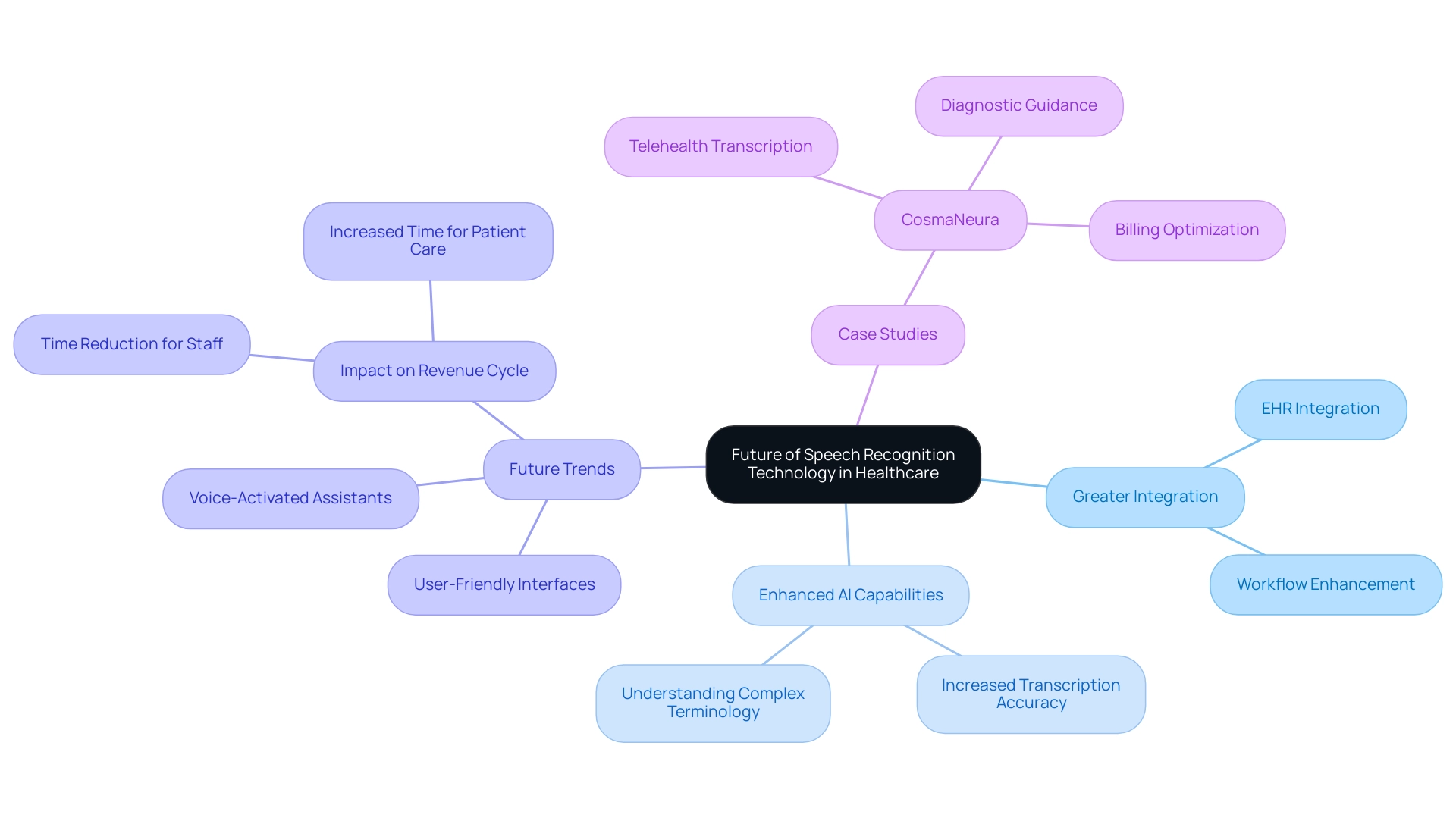
Conclusion
Embracing speech recognition technology in healthcare represents a significant step forward in enhancing operational efficiency and patient care. This innovative tool not only streamlines documentation processes, allowing healthcare providers to reclaim precious time for patient interactions, but it also significantly improves the accuracy of medical records. As providers increasingly adopt these solutions, they can focus on what truly matters—delivering compassionate care to their patients.
While the journey towards integrating speech recognition technology presents challenges, such as accuracy concerns and integration difficulties, the potential benefits far outweigh these hurdles. By prioritizing key features like accuracy, customization, and security, healthcare organizations can effectively navigate these obstacles. Moreover, the growing trend towards on-device processing and enhanced AI capabilities promises to further bolster the reliability and efficiency of these systems.
Looking ahead, the future of speech recognition technology in healthcare is bright. With ongoing advancements and a greater emphasis on seamless integration with existing systems, this technology is poised to redefine how medical professionals document patient interactions. As the industry progresses, embracing these innovations will be essential for providers committed to improving patient outcomes, fostering a more effective healthcare delivery system, and ultimately enhancing the quality of care.




